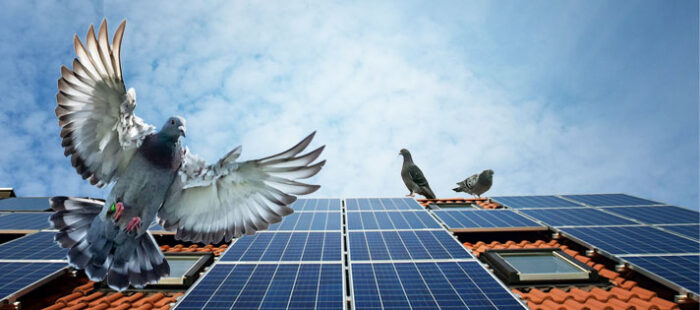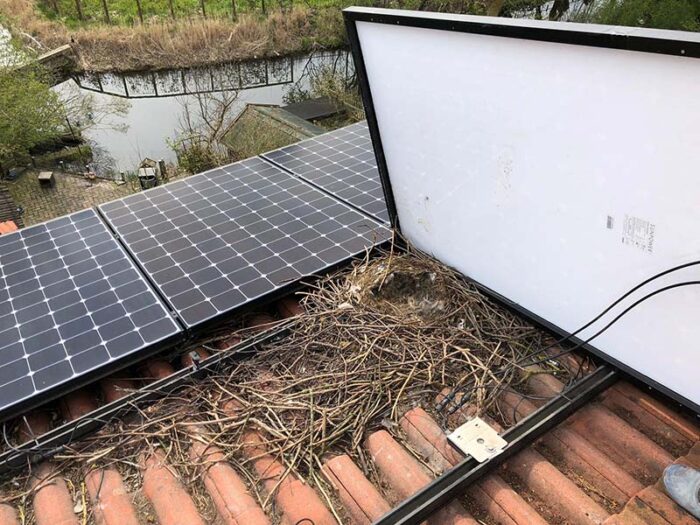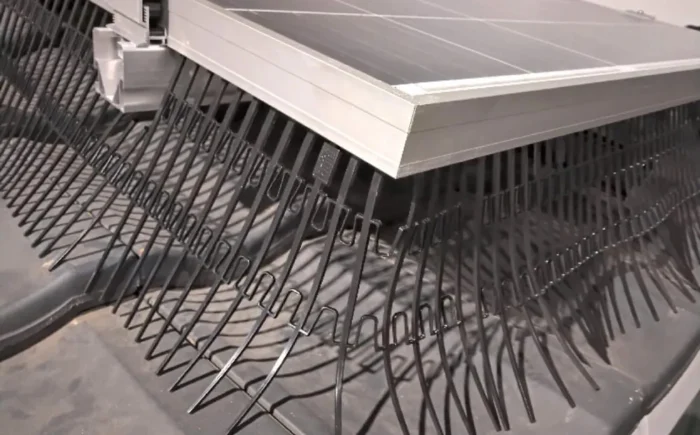Problems with Pigeons and Panels
Post by
Hazel Sturgess – Head of European Marketing, CCL Components – 21/07/23

2-minute read
Right now, I’m watching a pigeon bob down into the nest it’s crafted under the
solar modules on a neighbouring roof. From the pigeon’s point of view, it’s an ideal place to build a home. As well as shelter from predators and the elements, the modules offer warmth during the colder months from the heat they emit.
The comings and goings necessary for the nest build followed by the seemingly relentless trips back and forth to satisfy hungry chicks has provided my very own version of Spring Watch. But for the unwitting system owners, choice of location from the new family that’s moved in upstairs is far from ideal.

Birds nesting under
solar modules can result in heating as well as chemical and mechanical damage to a PV system. Acidity in bird droppings can erode both cables and the surface of modules. A build-up of twigs and nest material can scuff the panel back sheets causing earth leakage and will restrict ventilation beneath them. Restricted airflow causes the modules to heat up and, once they’ve reached a temperature of around 25⁰C, efficiency will start to drop. Birds also have a habit of pecking at the cables and scratching the modules’ surfaces. Any damage to a module can impact its performance, lowering power yield, and may lead to system faults. In extreme cases, exposed cabling poses a fire hazard.

The majority of installers are well aware of the problems that birds can cause and a quick audit of a number of websites today demonstrated that most offer a variety of mesh guards and blocking strips to prevent their access. However, the way that the guard is fixed is rarely mentioned. Unfortunately, anecdotal evidence suggests that, often, the frame of the panel is drilled. Put simply, this is a really bad idea. Drilling additional holes in any part of a module will invalidate the product warranty.
Instead of swapping one problem for one less immediately obvious, there is a very simple answer: clips. Van Der Valk offer
BirdBlocker strip and clips enabling a guard to be installed without impacting the module.
There is one final, important note of caution. In England and Wales all wild birds, their young, nests and eggs are protected under the Wildlife & Countryside Act 1981. It's an offence to damage or destroy the nest of any wild bird while it's in use or being built and to destroy or remove any egg of any wild bird. The basis of Scotland's wild bird legislation is the same. So, until the hungry chicks fledge, the twiggy home of the neighbours’ neighbours remains safe for now.
 2-minute read
Right now, I’m watching a pigeon bob down into the nest it’s crafted under the solar modules on a neighbouring roof. From the pigeon’s point of view, it’s an ideal place to build a home. As well as shelter from predators and the elements, the modules offer warmth during the colder months from the heat they emit.
The comings and goings necessary for the nest build followed by the seemingly relentless trips back and forth to satisfy hungry chicks has provided my very own version of Spring Watch. But for the unwitting system owners, choice of location from the new family that’s moved in upstairs is far from ideal.
2-minute read
Right now, I’m watching a pigeon bob down into the nest it’s crafted under the solar modules on a neighbouring roof. From the pigeon’s point of view, it’s an ideal place to build a home. As well as shelter from predators and the elements, the modules offer warmth during the colder months from the heat they emit.
The comings and goings necessary for the nest build followed by the seemingly relentless trips back and forth to satisfy hungry chicks has provided my very own version of Spring Watch. But for the unwitting system owners, choice of location from the new family that’s moved in upstairs is far from ideal.
 Birds nesting under solar modules can result in heating as well as chemical and mechanical damage to a PV system. Acidity in bird droppings can erode both cables and the surface of modules. A build-up of twigs and nest material can scuff the panel back sheets causing earth leakage and will restrict ventilation beneath them. Restricted airflow causes the modules to heat up and, once they’ve reached a temperature of around 25⁰C, efficiency will start to drop. Birds also have a habit of pecking at the cables and scratching the modules’ surfaces. Any damage to a module can impact its performance, lowering power yield, and may lead to system faults. In extreme cases, exposed cabling poses a fire hazard.
Birds nesting under solar modules can result in heating as well as chemical and mechanical damage to a PV system. Acidity in bird droppings can erode both cables and the surface of modules. A build-up of twigs and nest material can scuff the panel back sheets causing earth leakage and will restrict ventilation beneath them. Restricted airflow causes the modules to heat up and, once they’ve reached a temperature of around 25⁰C, efficiency will start to drop. Birds also have a habit of pecking at the cables and scratching the modules’ surfaces. Any damage to a module can impact its performance, lowering power yield, and may lead to system faults. In extreme cases, exposed cabling poses a fire hazard.
 The majority of installers are well aware of the problems that birds can cause and a quick audit of a number of websites today demonstrated that most offer a variety of mesh guards and blocking strips to prevent their access. However, the way that the guard is fixed is rarely mentioned. Unfortunately, anecdotal evidence suggests that, often, the frame of the panel is drilled. Put simply, this is a really bad idea. Drilling additional holes in any part of a module will invalidate the product warranty.
Instead of swapping one problem for one less immediately obvious, there is a very simple answer: clips. Van Der Valk offer BirdBlocker strip and clips enabling a guard to be installed without impacting the module.
There is one final, important note of caution. In England and Wales all wild birds, their young, nests and eggs are protected under the Wildlife & Countryside Act 1981. It's an offence to damage or destroy the nest of any wild bird while it's in use or being built and to destroy or remove any egg of any wild bird. The basis of Scotland's wild bird legislation is the same. So, until the hungry chicks fledge, the twiggy home of the neighbours’ neighbours remains safe for now.
The majority of installers are well aware of the problems that birds can cause and a quick audit of a number of websites today demonstrated that most offer a variety of mesh guards and blocking strips to prevent their access. However, the way that the guard is fixed is rarely mentioned. Unfortunately, anecdotal evidence suggests that, often, the frame of the panel is drilled. Put simply, this is a really bad idea. Drilling additional holes in any part of a module will invalidate the product warranty.
Instead of swapping one problem for one less immediately obvious, there is a very simple answer: clips. Van Der Valk offer BirdBlocker strip and clips enabling a guard to be installed without impacting the module.
There is one final, important note of caution. In England and Wales all wild birds, their young, nests and eggs are protected under the Wildlife & Countryside Act 1981. It's an offence to damage or destroy the nest of any wild bird while it's in use or being built and to destroy or remove any egg of any wild bird. The basis of Scotland's wild bird legislation is the same. So, until the hungry chicks fledge, the twiggy home of the neighbours’ neighbours remains safe for now. 